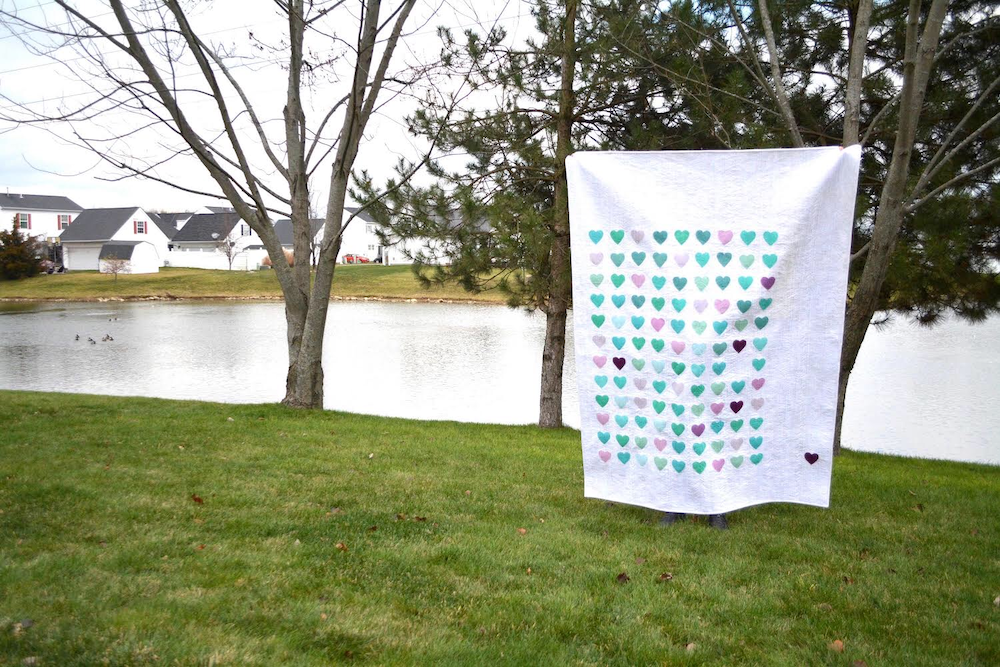Heart Quilt: An Epilepsy Story
My latest quilt finish comes with a story that I’ve been nervous to tell. But with vulnerability comes community, so here goes…

A couple months after sending our little guy off to kindergarten, my husband and I knew that something was wrong.
We’d noticed it off and on for the greater part of 2019, but were never quite sure if our eyes were playing tricks on us. Often when we’d be talking to our son he’d start to respond, and then his eyes would stare off into space for a few seconds. We’d call his name with no response. When he came back around, usually 2 to 5 seconds later, he wondered why we were looking at him so funny.
I Googled this phenomenon, and came up with a concerning possibility. He could have a disorder called Childhood Absence Epilepsy (CAE). Kids with “absence seizures” have frequent, short-term blank-outs where they are unaware of what is happening around them. For our son, it often happened when he was concentrating, like playing a board game. We noticed that tiredness was often a trigger. Some days we didn’t notice any. It didn’t seem to affect his day-to-day life, and some days we didn’t notice any episodes. Other days, it would happen a dozen times a day, only for a few seconds at a time.
But we were terrified to get him tested, because an official diagnosis would feel like a punch to the gut.
Deep down, we didn’t want it to be true. We didn’t want to take away his innocence. We didn’t want to put him through a sleep-deprived brain test with wires glued to his head. After all, that meant we’d have to tell him what was going on. It hurt us to put that burden on our little boy, to make him think anything was wrong. We didn’t want to go through it unless we absolutely had to, so we waited.

Then one day, my husband was sitting on the couch with our son when one of the absence seizures occurred, and it was clear as day.
“Hey daddy, guess what?”
“What?” my husband asked.
Then our son’s eyes rolled back, and he said nothing.
Our task was clear. We scheduled the EEG, and a we were able to get into Riley Pediatric Neurology within weeks.
“Make sure he only sleeps 4 hours the night before the EEG.”
I scoured message boards for advice on how other parents handled this task. While Matt went to bed early, our then 5-year-old and I had a massive “stay up” party in the living room, complete with dance music, movies, a painting station, sticky ninjas, glow-in-the-dark balloons. It was actually a riot! A bit of joy in the midst of something so strange. At 2am, he said, “Mommy, I want to go to bed.” So I tucked him in, and dutifully set my alarm for 6am. When the alarm went off, I climbed in his bed and suggested we finish watching a movie on my laptop while we waited for the 9am appointment.
As we walked into Riley, we were deeply aware of the situations around us. We were going in for a scary test. But many families inside those doors faced situations much scarier and more life-shattering, like the possibility of losing their child to cancer. Waiting for a donor. We ourselves were on edge, but tried to be the solid rock for our son, keeping a positive attitude and breathing deep, so nonchalant about this whole brain test.
During the test, our son had colorful wires glued to his scalp. Then the nurse wrapped the wires in white gauze, and instructed him to answer questions while trying to sleep in the darkened room. She said things like, “Seven…. purple…. cow….” Then she’d write down notes, while the computer screens showed brain patterns. We didn’t know what any of it meant. As we left the room, the nurse pulled my husband aside and said, “I’m not allowed to tell you anything, but make sure you don’t leave him alone in the bathtub.”

The diagnosis came quickly. Within the week, we had a new prescription and a new identity: parents of a child with epilepsy.
As we’d come to learn, Childhood Absence Epilepsy is a little different than other conditions, in that there’s a good chance kids can grow out of it. They can go on medication to control the seizures, then get tested a few years down the road and find that they are able to wean off the meds.
October 2020 marked one year of managing our son’s absence seizures. We have been very fortunate that the first medicine we tried worked. The seizures disappeared. He doesn’t like taking the medication, and hates that he has to eat something before slurping down the red liquid. Every fourth day or so, there’s a moment of distress where he admits total frustration over having to take it. But if that’s our current battle, we’ll take it.
In my research of absence seizures, I reached out to a quilting friend whose daughter also had this same test and diagnosis. Even the same medication. It was life-changing to have a friend to walk through this with me.
In fact, a few months after his diagnosis, I was teaching preschool when another teacher came to me and explained that her nephew was getting tested for the same condition. She was scared, and I told her everything I knew. I felt like our family had already walked that scary plank, and it was all I wanted to do to console someone else facing that same set of unknowns.

So, about this quilt….
It has 4 dark purple hearts, symbolizing the 1 in 26 people who will live with epilepsy in their lifetime. Epilepsy affects children and adults of all ages, races, and ethnic groups. It is the fourth most common neurological disease. (source: Epilepsy Foundation)
It has 21 light purple hearts, which stand for the 1 in 4 children who will live with some type of neurological condition, including autism, seizures, strokes, and more. (source: Child Neurology Foundation)
It has 74 green hearts. They are assorted colors, because no two lives are the same, and even without the struggle of a brain condition, we all have our individual struggles in this life. Racism. Poverty. Abuse. Privilege. None of us has the perfect life, even if social media makes it appear this way. I wanted to honor the fact that every person has a story, and I am telling my own. It is not the best or the worst. It is just mine.
I used straight-line quilting and variety of thread colors to give it lots of texture. I have never quilted so heavily with straight lines, but it felt important and therapeutic to stitch my way through those individual hearts.
The hearts have rough edges. Each heart is made with raw-edge fusible applique to a white background. I originally planned to make another with turned edge applique, but I have found a beauty in the raw edges and their slight unraveling. It rings true to me in telling this part of our story.

Before making this quilt, I personally knew a handful of other children affected by seizures. As I shared my story with the people in my community, I learned of a few more. (“My grandson… My neighbor’s nephew… Me, when I was younger… My niece…”)
You may also know someone who is living with epilepsy.
Epilepsy can affect anyone with a brain.
Seizures can strike at any time, without warning or reason.
Additionally, one-third of people living with epilepsy have seizures that cannot be controlled with current treatments.
The uncertainty of when and where the next seizure may occur has a dramatic impact on the lives of all people living with epilepsy and on their loved ones.

I’m working on a pattern to share my process for making this quilt, which I look forward to sharing in the next few weeks! Thank you for hearing my story, and I’d love to be a resource, an open book, for anyone who is about to walk this road.





